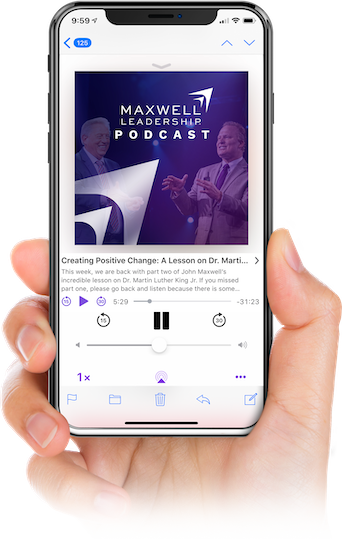Executive Leadership Podcast #191: Confronting the Challenges of a Post-Pandemic World

There is a lot of good news as the world comes out of the COVID years, but this also presents some challenges that leaders must confront. This week Chris Goede and Perry Holley share the importance of confronting challenges that have emerged from the post-pandemic world and how leaders can develop the skill of confrontation.
Want to enhance your organization’s leadership culture? Learn more about our 5 Levels of Leadership private workshops HERE – Offered virtually and on-site to meet your organization’s health guidelines.
Download our Learning Guide for this podcast!
Perry Holley: Welcome to the Maxwell Executive Leadership Podcast, where our goal is to help you increase your reputation as a leader, increase your ability to influence others and increase your ability to fully engage your team to deliver remarkable results. Hi, I’m Perry Holley a Maxwell Leadership facilitator and coach.
Chris Goede: And I’m Chris Goede, Executive Vice President of Maxwell Leadership. Welcome, and thank you for joining us. Perry, I’m just grateful for the amount of listens and downloads that we’re seeing each week. And we love the fact we’re hearing stories about, you’re taking this podcast, this lesson, you’re sharing it with the team. And then we have a lot of our clients and our partners that are actually using it, the first five or 10 minutes of their team meetings saying, “Hey, what was your biggest takeaway? What’d you learn?” It’s been a great conversation piece. So we are grateful for that.
Now, with that being said, if there’s a particular leadership topic or a question you have, maybe you want to download and look at the blog that goes along with this podcast or the learner guide, don’t hesitate to go to maxwellleadership.com/podcast. If you’ll click on this lesson once you’re there, you’ll see that form and the information inside that lesson.
Well today’s topic, and I think this is an extremely relevant one, we talk a lot about this in our consulting and our coaching opportunities with organizations. It is, Confronting the Challenge of a Post-Pandemic World. And there’s a lot of good news. There’s a lot of things that have turned and have changed. There’s a lot of companies that had a lot of success during the COVID years. There are companies, we understand on the other side of that. But with that being said, now there are some challenges coming out of that, for both sides of the coin in these organizations. And that’s what we’re going to talk a little bit about today.
Perry Holley: Yes it’s interesting. I’ve been working with leaders, especially in our coaching business. Here are the challenges that they’re needing to confront after we… Business is coming back. We’re beginning to reopen. Things are looking a little like normal again. I’ve been on airplanes. They are full. Everybody’s going someplace and it seems like we didn’t miss a beat here, but there’s a lot going on. So, I thought I would just capture some of these things I’ve been hearing and it occurred to me as I was thinking through, reflecting on ideas to bring to our audience here was, some of these challenges. I’ll love to get your point of view on those. We’ll just jump in.
The first challenge I’ve seen is something that we’ve warned about before on this podcast and that is, how we can form bad habits in good times. And I would just say, I’ll let you comment on this, but I bet most, if not all of the businesses we serve have had extraordinarily great results during the pandemic years. They pivoted, they figured it out. Business came to them instead of them having to go and find the business. This allowed sales and service and support teams to stop doing the things they used to have to do. This time of abundance, everything coming to me, has caused a formation of some bad habits that are now going to come to light as businesses reopen and customers return to old buying habits. So what are your thoughts on that one?
Chris Goede: How much time do we have? Because this is a topic of conversation with a lot of leaders. And here’s just two thoughts that come to mind when you talk about that. And by the way, we do understand, like I mentioned in the opening that there are some of us that during the pandemic world, really developed some good habits. Because they were bad times for us. And then there are others, as Perry was just talking about, clients and organizations, where things are going so well for them that they’re beginning to develop bad habits.
And my two thoughts are this that we talk about, which is really evaluate why are you being successful right now? To have that conversation, I think sometimes that’s the best time to reflect on when things are going well. Why are they going well? What this does is this really allows you to get to the root cause of why things are going well. And it brings to the attention that it’s really not the individual. It’s really not the people that are leading. It’s really not, you know? And so we talk about momentum and we talk about it both ways, and we say, “Hey, when things are going bad, that’s not necessarily a reflection of your leadership. By the way, when things are going really well, it’s not a reflection on your leadership.” And so make sure that you’re going through the process and during these good times, you’re evaluating, why are we being successful? And really, really putting a microscope on the daily habits of what you’re doing.
The other thing I thought about was to really focus on when you look at this, yes, the end result and the KPIs are beneficial, but really focus and look at the attitudes, the activities, and the strategies behind what you’re doing. And maybe even go back and say, “Hey, when we were really in bad times, what were our attitudes and what were the activities and what was the strategy that we were going through? And then how do we compare that to what we’re doing now?” There may be a big gap. They may be better. That’d be great, right? So that when the tide does turn, and by the way, it’s going to turn again, that we are in alignment with what got us there. So those were two things that came to my mind in conversations that I’ve had recently with leaders coming and leading through this post-pandemic time.
To be a Successful Leader, You Need Feedback on Your Leadership.
We’re excited to announce our new and improved Organizational Effectiveness Survey (OES). The OES gathers feedback from employees to give leaders and management the knowledge and action plans needed to develop a more effective and productive work environment. Our new version measures 4 areas of your business: Leadership, People, Strategy, and Performance.
Perry Holley: Yeah. Yeah. And the reason I think it’s confrontational now is you got to really confront it as a leader is, if you continue these habits that we maybe picked up and customers are returning to a certain way of buying, wow, that’s going to really show up as they don’t really need you as much as they did in the pandemic. There’s other places to turn. I really want my teams really to focus on those good habits like you said. Another area came up, maybe it is around some of those good habits, good things that happened in the pandemic was we did pivot. We did have to learn new ways of doing things. And I’ve seen a couple of examples recently where the team is tempted to return to their pre-pandemic ways of doing things and lose all that innovative thinking that led to these terrific results in a tough market. Hey, we’ll just go back to doing things the old way. And I think that’s a fantastic place for a leader to confront those behaviors and not lose the learning.
Chris Goede: Well, I think as leaders, sometimes we’ll see maybe in ourselves and in others, we’ll see this path of least resistance, is what you’re telling us, right? And it’s like, “Okay, well, this was really hard for about 18 24, 36 months. Now we’re going to fall back into it doesn’t need to be that hard. We don’t need to be doing certain things. And so we’ll go back to a more complacent mindset. We’ll go back to the way things were.” And I think we just need to continue to push ourselves as leaders to always be a change agent for our team, for our organization. And to always continue to push that needle. I look at the way that you and I have helped our team do business a little bit differently through that. And so I think it would be a shame for us to go back to the old ways.
Not only does it not serve us well, but it doesn’t serve our customer well. And we’ve even seen it too, with a lot of organizations, they used to have these big annual retreats, and now they realize they’re able to do them a little bit differently and to be able to do it virtually and to have some blended learning and do different things. And so I think it would be a shame if we, to your point, fell back and just did things the way we used to do them pre-pandemic.
Perry Holley: Right. Right. A third area that popped up on a call recently was I’ve seen it a little bit leaders struggling with how do we do work now? The pandemic forced us into finding new ways to work remotely, to keep business going but without being in person. I think many businesses now are struggling with when to come back, if to come back to the office, to come back completely. Some workers were forced to work from home. Many of them found that they really like it and they don’t want to return. Of course, circumstances vary for everyone.
I think you got to be really careful as a leader here, but you’re probably going to need to confront the issue head on and use your influence to position the workforce for the best possible performance for your organization. Now, I spoke with a leader recently who had a department manager who is staying home when the rest of the team is mostly back in the office. And this is causing a real disconnect in relationships in the work assignments. But the manager said, “No, it’s no big deal. We’ve been doing this for two years.” But that’s not the perception it has in the office. And it’s causing some problems and some miscommunications and some lack of clarity and some other things going on because this leader, I said, “You’re going to have to step up to, how are you going to do work now?”
Chris Goede: Yeah, that’s a tough situation, right? Especially as a leader, this is a personal answer right here, but I would want to be with my people. I would want to be, as often as possible, be with them. And so it is hard. Now I know sometimes demographics will cause us not to be able to do that, but if the whole team’s together, that’s a tough situation for that leader to be working through. I think we have to continue to, and always should, respect people’s feelings and the lingering effects that come with this. We want to make sure that our team are and feel safe in whatever that might be. And so that’s a big part of that. And we don’t want to just chalk that off, but I do think that we need to run a business. And we need to understand that sometimes we do need to have those conversations where, “Hey, here’s our expectations.”
Or maybe even getting a better understanding of what it is and why they want to work full-time remote. And I know I’ve had conversations with my team to where now we have this kind of blended approach to what they’re doing and trying to better understand why is it that they want… And just to begin having that conversation instead of just having that ultimatum one way or another, because I think if you do that, your team does not feel heard. They may not feel safe and that’s not necessarily going to help you accomplish anything.
The other thing is here, is I want to make sure when you have these conversations, you’re confronting the behavior, not necessarily the person, throughout that process. And so there’s creative ways to do that and to be able to still get your point across, the organization’s stance across in a way that the person is they’re heard and understood, they understand your side of things. And you’re able to come to resolution to where you’re still allowed maybe to work a little bit remote, but still get some business done at the pace of which you want it to get done.
Perry Holley: All right. Well, that leader told me that the manager didn’t think it was a problem. And so I said, “The first thing you need to confront is an agreed upon assessment of reality, that there may be a blind spot there, but it feels normal and natural to her to be at home, because she’s been there for two years, but the team is not being perceived that way.” So there’s a bit of a gap on how reality’s being looked at. But before we close, maybe I should get you to just comment a bit on… We’ve been using the word confront or confrontation and many people, it’s something that they don’t want to do. It’s a type of void or a push off and delay and that sort of thing. But I think it’s a skill that leaders need to possess. What is your view on this confrontation, the aspect that we need to step toward it, not away from it?
Chris Goede: Well, if you don’t address it, if you don’t have these conversations or confront, I think you make situations 10X worse by not doing it. I think that it is a skill and I think that if you do it incorrectly, it will make things worse, as I mentioned. What’s interesting about this, is that you and I have talked quite a bit about in sessions with organizations, with teams, the individual’s confrontation index. And through one of our assessments, we’re actually able to begin to understand, “Hey, Perry has a certain confrontation index because of how he’s wired.” I do as well. And that allows you to have conversations a little bit more effectively and to understand where your leader stands or where you stand, when it comes to confrontation.
And I think that, I think it was Liz Wiseman. Is she the one that said, when it comes to confronting, the best way to do is what she calls hard/easy versus easy/hard. And as leaders, sometimes you got to have the hard conversation up front and confront right away, so that it’s easier on the back end versus allowing things to happen, where it builds up frustration. And then it becomes a very difficult conversation. And so I always encourage real time response and getting to the point to where you understand their intent, they understand yours, and then you can get beyond that. But it is a skillset and it is something that needs to be continually looked at and worked on.
Perry Holley: Yeah. I appreciate you talking about intent. I was thinking, my own personal model, and we were just teaching this last week with a client out West on how to have a difficult conversation. And that’s a bit about con confronting people for either performance or something else going on. But checking my motive. What is the outcome? What’s the story they’re telling themselves? What is mine? How do I see it, but how do they see it? And then inviting input and conversation. I think the motive to me was so key to say, I’m not trying to win or be right when I confront someone.
I think about the three questions that every follower wants to know about you. We talk about that a lot, that if they know that as a leader, I’m trying to help them, first question. That I care about them, second question. And that they can trust me, third question. That even if I’m confronting and it seems hard, my motive is really, I want to help you. I care about you. You can trust me. We’re trying to get past this and grow from it. So I think it has a lot to do with how you develop that skill, but it starts with what your motive is.
Chris Goede: Yeah. And confronting doesn’t need to be a negative thing. Now, is it easy? It’s not easy, but it doesn’t need to be negative. And I think that John talks a lot about how your connection over the content of what you are actually talking about. Remember, so the content is around what we’re trying to confront on, but don’t lose the connection. Can you maintain the connection with the individual? It comes back to even The 5 Levels of Leadership, right? Where we talk about Level 2, this is where we connect with people. And so that’s so important. And that’s the foundation of leadership that we need to keep that connection with individuals, no matter what the conversation is. And so many times we deliver the content of our message without thinking about, what is our connection with the individual and is the connection safe? And so when you think about that, just remember the connection is as important, if not more than the content that you’re covering, that you’re talking about during the time that you’re having to have these confrontations.
Perry Holley: Wow. I love that lesson. Because really when we get into it really is all about the content. And I don’t even think about, you need to man up and handle it. No, no, no, I need to protect that. And I’ll tell you another thing, I apply that one at home as much as I do at work is, don’t sacrifice connection with the people that mean the most to me in life over wanting to be right or thinking I have the high ground. It’s just such a great lesson to do that. So why don’t you wrap it up for us and we’ll take it home.
Chris Goede: Yeah, I’d love to. So as we talk about Confronting the Challenges in this Post-Pandemic World, remember ask yourself some questions, some simple questions. What is working, what’s not working and why is it working and what not working? I think there’ll be some reality behind that. We work with a lot of people in different industries where, I’m not sure they really have dug into, why are we being so successful? And so as you go through that, make sure that you’re doing that.
And remember, we just talked about this for the last couple minutes of it, but I think this is really, really important, especially in this post-pandemic, because it covers so many things we’ve talked about, which is make sure that you understand, as people we’re built for connection, first. And we’ve got to respect that and we have to have interaction. We got to be with individuals, whether that’s getting creative from a remote standpoint, whether we’re in the office a little bit more, whether it’s a blended approach. And then we have to have that connection through conversations. And those conversations, sometimes they can be hard and sometimes they can be easy. But as Liz said, it’s much easier to go the hard route first and do the hard/easy versus the easy/hard.
Perry Holley: Yeah. Love that. Thanks Chris. That’s good stuff. Just a reminder, if you’d like the learner guide for today’s episode, you can download that as well as leave us a question or a comment or learn more about our offerings at maxwellleadership.com/podcast. We always love hearing from you and we’re very grateful you would spend this time with us. That’s all today from the Maxwell Executive Leadership Podcast.












Be the first to comment on "Executive Leadership Podcast #191: Confronting the Challenges of a Post-Pandemic World"